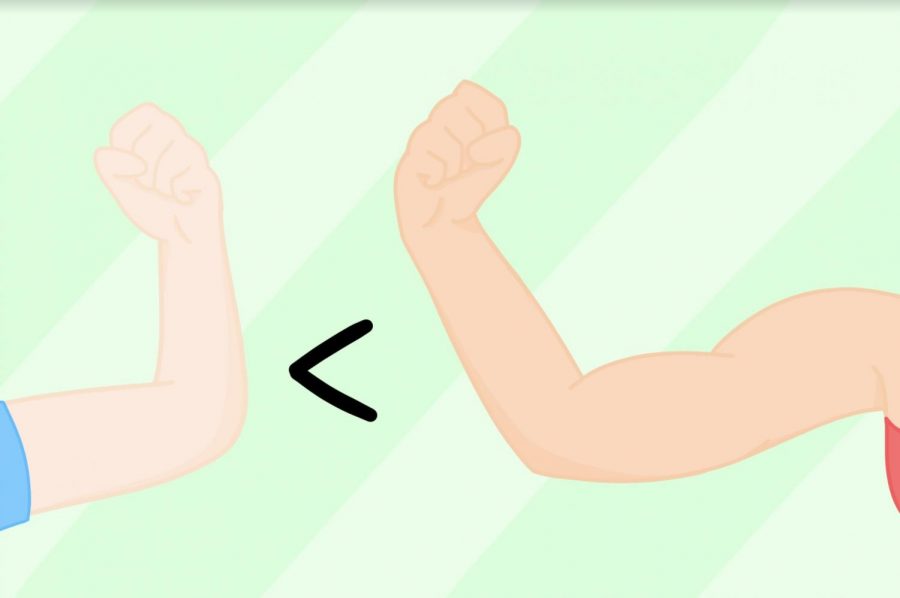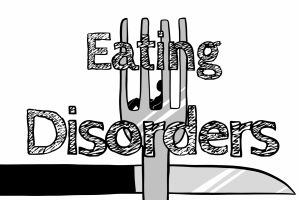Ansley’s column: Strong > skinny
The following is part of a regular column written by Senior Writer Ansley Morris.
Original art by staff artist, Evanthia Stirou, represents the idea that strong and healthy is greater than skinny.
April 27, 2021
As I’ve shared earlier in the year, I spent a good portion of my past year dealing with and recovering from an eating disorder that brought with it with the deadset determination to be nothing but skinny— to be as small as possible. Now, a year later, I’ve gone from wanting to be nothing more than skin and bones to working to be strong and healthy.
One of the main ways I’ve done this was through the process of falling in love with the gym. I’ve always been pretty active through sports and occasionally running the treadmill, but in the past couple of months, I’ve spent a majority of my active time lifting weights and loving it (compared to spending hours doing cardio that I hated).
But, regardless of how you’re keeping yourself active, whether it be lifting, running, swimming, or going on walks, I’ve learned that there’s so much more to working out than just wanting to lose weight.
I love the adrenaline rush and serotonin boost I get from pushing myself to pick up heavier and heavier weights. As the days go on, I not only can see the progress I’m making, but I feel stronger and happier than ever in those moments.
Working out increases endorphins, but what you may not know is that there’s a specific chemical called myokine released when your muscles contract. Myokine has been shown to relieve stress and boost happiness, which helps people with anxiety and depression (both of which are commonly tied to eating disorders).
I’d spent the majority of this school year working to recover mentally through things like facing my fear of foods or doing things that make me happy. But, I noticed that when I began consistently going to the gym, there was an even greater shift in my mentality that pushed my recovery above and beyond.
I went into the gym with a goal to be healthy and strong, the exact opposite of the mindset that my toxic eating disorder offered me.
While I definitely still have my moments of body image insecurity, I’m beyond proud of the progress I’ve made both physically and mentally. I went from drowning in a mindset clouded with negativity, judgment, and guilt to a place where I can (for the most part) love my body and what it does for me every day, regardless of the number on the scale.
During the worst part of my eating disorder, my weight dipped down to about 120 pounds, which in my head was still way too high of a number even though I’m 5’10. Now, I’m almost at 140 pounds and more confident in my appearance than ever.
Now, don’t get me wrong, I’ve really only started feeling as good as I have in the past couple of weeks, maybe a month. I’m still in the very beginning of this process, but after just a couple of months of consistently working out and fueling my body with the right foods, and I not only see a shift in my physical appearance, but my mental state and body image is at a place where I could’ve never imagined it being at the beginning of this school year.
Not only was the gym a source of this mental boost, but I’ve also been learning more about health when it comes to foods and diet, which has complemented the transformation. Every day, I learn more about what foods make me feel good instead of solely focusing on the number of calories.
As my body goals began to shift from skinny to strong, that also meant my food goals would have to, too. In order to see and feel progress in the work I was putting in at the gym, I had to eat more. I went from eating 500-600 calories a day (which is healthy for no one, no matter how much you workout) to well over 2,000, and I couldn’t be happier about it.
While I do try to fill my diet with healthier foods that make me feel more energized and happier throughout the day, I’ve also allowed myself to still give in to my cravings for that chocolate cake or burrito and not feel bad about it. I’m eating food that I love and feeling great about it. Food freedom (the ability to take control over your eating habits, instead of letting food control you) is possible, and that’s one of the most valuable things I’ve learned in this recovery and growth process.
My goal this year was to step out of my comfort zone in a way that I know would benefit my overall health and well-being. Transitioning from doing quick 10-minute ab exercises and running on a treadmill to lifting weights in the gym in thorough workouts has been one of the best things I could’ve done for myself.
In August, I would’ve never imagined that lifting heavy weights and eating copious amounts of carbs and protein would be such a big part of my life, but pretty much as soon as I picked these habits up, there was a huge, positive shift.
So, as you’re comfortable, head on over to the gym, pick up some dumbbells and see if weightlifting is for you. If not, that’s okay, but my one piece of advice is to step out of your comfort zone and do something that you know is good for you.




























































